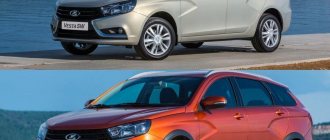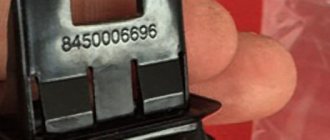Today it demonstrates enviable progress, delighting its fans with new and promising models that can successfully compete with foreign cars. A striking new product that has been seriously talked about in the global automotive arena is the Lada Vesta. Only the best constructive ideas and solutions that can be found today among foreign manufacturers are reflected in this “Russian”.
Probably, many will be interested: where is the Lada Vesta car assembled? In what city? Therefore, today we will talk specifically about this topic.
Start of production of Lada Vesta
September 2015. A model still unknown to the general public, the Lada Vesta, is launched into production. After a couple of months on the assembly line, the first copies appear on sale. Experts are very skeptical about the start of implementation, predicting the Lada Vesta will be the same failure as its predecessors.
However, over time the picture became completely different. Lada Vesta began to be bought up in large quantities, which became a reason to compare it with the best foreign cars on the market in the budget niche.
How did the manufacturer manage to succeed so much? It's simple: thanks to high consumer qualities, including:
- affordability;
- ergonomic and cozy interior;
- competitive and attractive exterior;
- capacity;
- the presence of modern assistant systems (ESP, ABS, etc.);
- fairly high degree of safety (2 airbags).
Where is the people's car assembled? Novaya Vesta is produced in Izhevsk. It also produces the Granta in the liftback version. The production of the new model was not without the participation of Renault engineers. They assisted in the design of the body, which was recreated using modern software. As a result of this interaction, Vesta’s body frame is not inferior in strength to the famous Ford Focus. The first crash tests have already confirmed this fact. In what city is the popular car in Russia still assembled?
Exclusive from the Izhevsk Automobile Plant: how are LADA Vestas produced? Details
Do you know, dear friends, what happened to one of the most valuable employees of our editorial office?
The man fell in love - passionately and at first sight.
Just think, you will say and you will be wrong, because it was this love that called us on the road.
To the homeland of the bride, that is, the West, that is, of course, LADA Vesta SW and LADA Vesta SW Cross.
To Izhevsk, as you understand.
It was from there that both premieres from AVTOVAZ came from, which somehow immediately became hits.
The subsidiary of PJSC AVTOVAZ in Chuvashia (the only one, please note) is Cheboksary-Lada, Novocheboksarsk, our reliable partner. And only thanks to Cheboksary-Lada this excursion took place.
We know that you are also very interested in how the LADA Vesta SW and LADA Vesta SW Cross are produced, but you can only get to the Izhevsk Automobile Plant, if you don’t work there, once a year. Don’t be upset, you have us, and right now we will tell and show you everything.
at LADA Izhevsk , but very soon the production of the latter will be transferred to the car plant in Tolyatti. The move will begin already during the New Year holidays, and thus production capacity will be freed up to increase the volume of LADA Vesta.
It was: 30 cars per hour (22 LADA Vesta and 8 Liftback). Will become: 30 LADA Vesta per hour.
Let's return, perhaps, from heaven to production.
Stamping
For the production of LADA Vesta SW and LADA Vesta SW Cross, stamping of 79 new and modified body parts was mastered here. There is a special control table for each of them. Two years ago, a new XL press line went into operation (four presses with a total force of 5,400 tons) - for large stampings (sidewalls, doors, wings, etc.). In 2015, the workshop was significantly modernized for its own production under the supervision of Japanese specialists.
Welding
This workshop also received a new birth with the arrival of LADA Granta production and additional modernization with the production of LADA Vesta. Parts of future machines travel along a one-kilometer transport line. Real, live welders are assisted by robotic welders - for example, 36 automatic line robots are used to weld the chassis and body.
In order to see what is happening in this workshop without harm to health, special glasses are issued. Very stylish. We even had some bad plans, but quickly became ashamed and returned the property to AVTOVAZ. And so they could set a fashion trend in their native Cheboksary.
The welded elements are run through a 3D control and measurement laboratory. Thousand-watt lamps reveal even the smallest defects, which are immediately corrected, if any.
The skeleton of the future car, moving along the conveyor, acquires wings, doors, trunk lid and hood, passes the next control point, and then is sent for painting.
Coloring
But for obvious reasons, we will not be able to show you the painting, since this is an automatic process that takes place behind closed doors. Harmful fumes and all that. Note that today LADA Vesta SW and LADA Vesta SW Cross are presented in eighteen colors, the basic one being white.
Assembly
The bodies leaving the painting shop again lose their doors. This was done, firstly, to make assembly easier inside and outside the cabins, and secondly, a separate door assembly area increases work efficiency and reduces the likelihood of defects. The finished doors are returned to the same body from which they were removed.
Conveyor workers place the engine, instrument panel, seats and all the other stuffing on the cars moving around the ring. The process looks fascinating: several people are working on one machine at the same time - here everyone has their own area and their own tasks. It takes 19 hours to assemble one car from scratch.
conveyor
conveyor
An electronic control system has been created in the assembly shop; manipulators and robots help people.
And - hurray! – the finished car goes to final testing. The new car will have to go through five main test posts: adjusting wheel geometry and headlights, a vehicle dynamic test stand, a wheel lateral slip tester, an electronic control systems tester, and a leak test chamber. The vehicle then goes through the AVES quality system. At the exit there is a special area where testers drive new cars back and forth. People's work is interesting and creative.
Meanwhile, on the day of our visit, the LADA Izhevsk plant produced its 5 millionth car - since the opening of the enterprise in December 1966. The hero of the day was the LADA Vesta SW Cross station wagon in carnelian color.
Having clocked up about seven kilometers at the factory, we left the entrance, immersed in simple mathematical calculations about how much love costs. And they couldn’t pass by. Could you?
The museum displays mass-produced cars that are familiar to the residents of our country firsthand.
And some prototypes, created in a single copy...
But these beauties were not in a museum, but in a factory. And we can’t help but show them to you.
By the way, already in 1979 a car with an automatic transmission and a bomb red interior was introduced. Futurism. If the idea had received proper development at that time, the history of the domestic automobile industry would have taken on a completely different sound.
LADA 4x4 prototype.
The history of the Izhevsk Automobile Plant began fifty-two years ago, almost ended in the troubled times of perestroika, but today it is entering a new stage of its development. Which cannot but inspire optimism.
Did you know that before sending LADA Vesta SW and LADA Vesta SW Cross into mass production, LADA testers tested more than 100 prototypes? Testing took place both in laboratories and on the road, including crash tests with a full load on special cobblestone, dirt and gravel tracks. As well as climate studies at temperatures from minus 40 to plus 55 degrees.
Well, you know where to go to buy a new car.
We couldn’t resist another (how many?) test drive, try driving the LADA Vesta SW or LADA Vesta SW Cross too.
"Cheboksary-Lada", Novocheboksarsk, st. Vostochnaya, no. 6.
Assembly and painting of a domestic model
Where is the car assembled and finalized? Welding of the main body elements is carried out using advanced robotic equipment. Although this process minimizes the influence of the human factor, it could not be done without the presence of qualified assemblers. Each stage of the assembly line takes place with the participation of workers. They hang the body panels, attach the remaining frame elements, which are subsequently welded using robotic technology.
Previously, the quality of painting of domestic bodies caused a lot of indignation among buyers. Today the situation is different. For painting Lada Vesta Cross purchases materials from global manufacturers - leaders in this market segment. Technological methods of painting, drying, polishing and other processes are constantly being improved.
The welded body is initially dipped into a special tank filled with an anti-corrosion solution. Then comes the stage of treatment with catapharesis primer. A significant proportion of these manipulations are performed by automation, but qualified painters perform their work in those places where clumsy robotics cannot get close.
Removing the Kalina torpedo
The fuel pump does not work on Kalina
Speed sensor Kalina 8 valves
Radiators (cooling, heating, air conditioning systems): valeo brand, made in Russia
All three Vesta radiators from the French brand Valeo (a well-known component manufacturer) are distinguished by good workmanship, in no way inferior to their world analogues. During dismantling, it was difficult to suspect that the radiators were assembled in Tolyatti at Valeo’s own production site.
By the way, the competence of the employees of the hotline of the Russian representative office of Valeo (where we were transferred to answer questions) was called into question. They couldn’t say exactly what was being assembled at the Valeo site in Nizhny Novgorod, and when asked about production in Togliatti, we were told that there was no confidence that it was working at all, although the press service of AvtoVAZ firmly confirmed the opposite.
The final stage for Vesta
- At all stages of the production cycle, continuous supervision is carried out by engineering and technical personnel. The quality of a particular operation is checked.
- The developers took quite a lot of care about the level of equipment and the quality of the interior. Here you can see soundproofing and anti-vibration materials, which are present not only on the panels, but also applied to the bottom.
- The final stage of the assembly cycle of the Lada Vesta Cross today is little different from a similar process among foreign automakers. Upon completion of the painting work, the doors are dismantled again and sent to a special workshop, where they are finalized to a finished state.
- After installing the headlights, bumpers and other components, the body is mated to the suspension, powertrain and transmission line. Note that, in part, domestic developers use the foreign experience of world leaders in the auto industry.
- Today, the manufacturer does not intend to stop there and promises to expand the line with the introduction of a hatchback and a station wagon, in the same place where sedans are already produced.
Body, chassis, steering rack
Lada Vesta is made on the basis of a body with a subframe. This element, being part of the suspension, holds the engine on itself. Such solutions have not been used in production Ladas before.
Vesta subframe - front suspension element
Many new solutions can be found in the LADA B platform:
- The steering rack is now connected to an L-shaped arm, rather than to a protrusion at the base of the shock absorber (as it was before); Sedan front suspension
- The stabilizer was also improved: VAZ switched to using “long” struts;
- The rear suspension was copied from the Renault Megane, as was the steering rack.
Vesta’s body structure is a LADA C project. It was about a C-class sedan, which was being prepared for release in 2020.
LADA C, sedan, 2021
Unfortunately, the project did not go into series. But the developments were not in vain: some elements were strengthened, others, on the contrary, were lightened or removed. This is how the Vesta sedan body appeared.
Still, let’s answer the question on what basis the Lada Vesta is made:
- The body is a LADA C project, but with modifications;
- Rear suspension – Renault Megane;
- Front suspension - all components were developed from scratch;
- The design uses solutions that have never been used before: subframe, L-shaped arms, etc.
And now - some photos.
Front suspension (struts and arms) Rear suspension (elastic beam)
Let's sum it up
Many will ask: does the Lada Vesta Cross plan to be assembled somewhere other than Izhevsk? Yes! Assembly production at ChechenAvto is being established. The company is located in Argun. Also, Kazakh colleagues will soon begin cooperation with Tolyatti residents, since assembly will soon begin in Ust-Kamenogorsk at the facilities of BipekAvto, where other cars are also produced. Now you have become familiar with where Vesta is collected.
So, according to experts, today’s strategy of the Russian auto giant is correct, and it is not known in what city the model will be assembled in the future!
Production bases
Initially, it was assumed that the new Lada Vesta would be assembled at the main plant in Tolyatti. An assembly line was even set up, but overall it turned out to be not entirely profitable. And, this car required some cost adjustment to be made in order to prevent the price from being excessively inflated and to fall into the corridor allocated by marketers.
Therefore, it was decided that the new Lada Vesta would be produced at a ready-made test site in Izhevsk. Some parts are produced in the workshops of the main enterprise. That is, at the moment there are two fully operational production lines for the Lada Vesta car. However, one of them is currently not fully loaded.
New Lada: LADA Vesta family of the new model year - Official LADA website
What is definitely not in the news
After modifications, the LADA B platform acquired a modern look. Some familiar elements have disappeared from it. And now it doesn't have:
- Timing belt tension roller, which is replaced by one (21129) or two (21179) automatic rollers; Adjustable roller and automatic roller
- There is not a single part from the Granta front suspension. The same applies to racks;
- There is no starter produced by Russian companies, although a starter from Lada Granta (21901-3708010-00) should be suitable;
- There is no manual transmission for VAZ-2180 or 2181 (Kalina-2 and Granta).
Vesta also does not have a robotic gearbox combined with the HR16DE engine (Nissan). Similar configurations will not appear in the future.
The LADA B platform, as we see, has its own characteristics. And car owners will have to collect more information about them.
Chechenavto
Few people know, but car production in the Chechen Republic has been established since 2008. Therefore, knowledgeable people were not surprised by Ramzan Kadyrov’s statement that the launch of Lada Vesta in the republic will take place in 2021. But there is no official confirmation from AvtoVAZ managers yet. According to their statements, this issue is being coordinated.
Let's take a closer look at the prospects of this endeavor. For the production of the Vesta machine, there is already a production base here. Now the Lada Priora is being produced here, which is expected to be removed from the assembly line in the very near future. Stopping the ChechenAvto plant is not very profitable from all points of view.
Fuel consumption per 100 km
For country trips and around the city, this car is simply wonderful. The driver will be pleased with the efficiency of the Lada Vesta. Fuel consumption per 100 km is low. In the city it is 9.0-9.3 l/100 km, outside the city - 5.0-5.3 l/100 km.
New Lada: One day with Lada Vesta (test drive)
This car has a deeply modernized engine that produces 106 horsepower. An important criterion is adaptation to high temperature conditions.
The engine is able to start easily at temperatures below 30 degrees, and can also withstand high temperatures in hot summer conditions.
Part 1
Press production
. There are 130 presses and 36 lines on which medium and large body panels (sidewalls, hoods, doors, trunks, etc.) are produced. For Lada Vesta, 61 parts are stamped, and for Lada Vesta SW and Lada Vesta SW Cross - 64.
Body welding
. There are 22 robots working together with people here. You can brew 8 different models on one line. The workshop includes a control and measurement laboratory equipped with two 3D measuring machines. Special devices create a cloud of points that allow you to check how well the body geometry matches the mathematical model. After welding, the body is sent to the assembly line and then to the painting shop.
Painting line
. There are 12 German painting robots working in the workshop. This workshop is considered one of the best in Russia. A total of four layers are applied to the body: first primer, second primer, base enamel and varnish. A total of twenty colors can be painted on this line at the same time. There is a waxing area for hidden cavities to protect the body from any climate.











